Many, Many Special Immigration Provisions by Nation of Origin
While the Declaration of Independence declares that all men are created equal, our immigration rules suggest otherwise.
A recent Center for Immigration Studies research project has revealed that there are more than 300 circumstances in which nationals of given nations have rights that other foreigners lack, and that the list of such favored nations includes about 131 countries, with many nations whose people get immigration breaks of two or more kinds.
Most of these special, favorable arrangements are for non-immigrants; there are also 18 nations in which the opposite is true, but only for would-be permanent immigrants; that will be the subject of a later posting. These are four countries where years-to-decades long waiting lists slow the issuance of immigrant visas, and an overlapping group of 18 which are barred from our immigrant diversity lotteries.
Setting aside, for the moment, the special, positive deals for nearby Mexico and Canada, a subject to which we will return, people from most of the nations in the world have special, nonimmigrant access to the States.
Visa Waivers. The most significant of these special arrangements allows residents of 41 countries to come to the U.S. Mainland without the need for tourist visas. They are:
- Andorra, Australia, Austria, Belgium, Brunei, Chile, Croatia, Czech Republic, Denmark, Estonia, Finland, France, Germany, Greece, Hungary, Iceland, Ireland, Israel, Italy, Japan, Latvia, Liechtenstein, Lithuania, Luxembourg, Malta, Monaco, Netherlands, New Zealand, Norway, Poland, Portugal, San Marino, Singapore, Slovakia, Slovenia, South Korea, Spain, Sweden, Switzerland, Taiwan, and the United Kingdom.
These are all prosperous nations whose citizens are expected to return to their homelands; most are in Europe.
While people from the nations listed above can visit the U.S. Mainland and its territories without visas, there is a smaller list of places whose nationals can visit Guam and the nearby Commonwealth of the Northern Mariana Islands without tourist visas. There are a dozen nations in this category:
- Australia, Brunei, Hong Kong, Japan, Malaysia, Nauru, New Zealand, Papua-New Guinea, South Korea, Singapore, Taiwan, and the United Kingdom.
That eight of the nations on the short list are also on the longer list suggests something short of competence in the legislative process.
The Mainland version of these programs, counterparts of which are often available to touring U.S. citizens, have generated little controversy. On the other hand, the vote-less delegate to the U.S. House of Representatives from CNMI, Kilili Sablan, is said to be wanting to add China and the Philippines to the smaller list; this would simply add to the number of undocumented aliens in these two territories, which are overrun with them. Russia used to be on the short list, but was dropped a few years ago. There is currently a program that allows some Chinese to visit CNMI under some circumstances, but this is a minor movement with limited flights between the islands and China. For more on this unique situation see here.
Incidentally, speaking of our insular possessions, American Samoa does not participate in any of these programs, as it, alone among the territories, has its own immigration law. Jobless U.S. citizens, among others, are not allowed to settle in that territory.
TPS. Unlike visa waivers this program does not deal with arrivals in the U.S., but with aliens already here, largely illegally. The initials stand for Temporary Protected Status, a program that has been with us for more than 20 years. It is also a de facto permanent operation; once a country is on it, it almost always stays, via repeated 18-month extensions. New countries are added to it by administrative fiat, something that has happened frequently in recent months.
TPS is a nominal, short-term amnesty. If one is an alien from a listed country one can apply for the program and stay legally until the program ends. TPS status comes with a work permit and access to social security cards. In some instances, it takes the shape of Deferred Enforcement Departure (DED), which has pretty much the same characteristics as TPS. Both programs are designed to prevent aliens from forced deportation to nations suffering from revolutions, earthquakes, and other disasters.
The 18 nations whose citizens are current participants in the two programs are:
- Afghanistan, Burma (Myanmar), Cameroon, El Salvador, Ethiopia, Haiti, Honduras, Hong Kong (DED for certain ex-residents), Liberia (DED), Nepal, Nicaragua, Somalia, South Sudan, Sudan, Syria, Ukraine, Venezuela, and Yemen.
Some people in Hong Kong apparently could apply for either this program, or a visit to Guam and/or CNMI – an interesting choice. There is no other overlap between visa waivers and TPS.
Parole. Once upon a time parole was used only in individual cases of extreme need. For instance, Grandma, an alien with no rights to enter the U.S., was afflicted by a disease which could not be treated in her home country, or Uncle Joe, who was in another country and was equally without rights to enter the U.S., was needed by prosecutors as a witness in a criminal trial. Both could be paroled in temporarily, Grandma for the length of the treatment, and Uncle Joe for the duration of the trial. There were no numerical limits, but parole was used sparingly.
No longer.
In January President Biden announce a version of the parole program that will allow 30,000 entries a month from otherwise unqualified aliens from the following countries:
- Cuba, Haiti, Nicaragua, and Venezuela.
If all of these allowances in the CHNV program are, in fact, converted into admissions, that would expand the U.S. population by 360,000 a year. The nations are run by, in order, communists, crooks, communists, and communists. The new parolees will be eligible to work and to get benefits from the funds now flowing from Washington to the cities where the newcomers settle.
H-2A and H-2B. The longest list of (slightly) favored nations are of those whose natives can become H-2A farmworkers or non-ag H-2B workers. It consists of 89 nations:
- Andorra, Argentina, Australia, Austria, Barbados, Belgium, Bolivia, Bosnia and Herzegovina, Brazil, Brunei, Bulgaria, Canada, Chile, Colombia, Costa Rica, Croatia, Cyprus, Czech Republic, Denmark, Dominican Republic, Ecuador, El Salvador, Estonia, Eswatini (formerly Swaziland), Fiji, Finland, France, Germany, Greece, Grenada, Guatemala, Haiti, Honduras, Hungary, Iceland, Ireland, Israel, Italy, Jamaica, Japan, Kiribati, Latvia, Liechtenstein, Lithuania, Luxembourg, Madagascar, Malta, Mauritius, Mexico, Monaco, Mongolia*, Montenegro, Mozambique, Nauru, The Netherlands, New Zealand, Nicaragua, North Macedonia, Norway, Panama, Papua-New Guinea, Paraguay**, Peru, the Philippines*, Poland, Portugal, Romania, Saint Lucia, San Marino, Serbia, Singapore, Slovakia, Slovenia, Solomon Islands, South Africa, South Korea, Spain, St. Vincent and the Grenadines, Sweden, Switzerland, Taiwan, Timor-Leste, Thailand, Turkey, Tuvalu, Ukraine, the United Kingdom, Uruguay, and Vanuatu.
* Mongolia and The Philippines are eligible to participate in the H-2B program, but not H-2A.
** It is the reverse for Paraguay.
The Department of Homeland Security proposes to abolish this list, which would, among other things, open both programs to the massive foreign-worker export practices of China and India.
I would oppose such a proposal on the grounds that foreign-worker-using employers in the U.S. already have too many options and giving them more would lead to more exploitation of alien workers, and more displacement of American ones. For a discussion of this see this nearly 200-page item in the Federal Register.
Other Nonimmigrant Programs. In addition, there are two programs for Treaty Traders (E-1), and Treaty Investors (E-2); these arrangements are limited to two different lists of eligible countries neither of which includes either India or China. Both programs provide relatively easy- to-renew nonimmigrant visas for either well-to-do or well-connected aliens. For more on these programs see here.
Here is the list of the 42 E-1 nations:
- Argentina, Australia, Austria, Belgium, Bolivia, Bosnia, Brunei, Canada, Colombia, Costa Rica, Croatia, Denmark, Estonia, Ethiopia, Finland, France, Germany, Greece, Honduras, Iran, Ireland, Israel, Italy, Japan, Korea, Latvia, Liberia, Luxembourg, Mexico, Netherlands, Northern Macedonia, Norway, Oman, Pakistan, Paraguay, Philippines, Slovenia, Spain, Suriname Sweden, Switzerland, Taiwan, Thailand, Togo, Turkey, and the United Kingdom.
The E-2 list contains 81 nations, all on the E-1 list, plus these:
- Albania, Armenia, Azerbaijan, Bahrain, Bangladesh, Bulgaria, Cameroon, Chile, Congo (Brazzaville) Congo (Kinshasa), Czech Republic, Ecuador, Egypt, Georgia, Grenada, Jamaica, Jordan, Kazakhstan, Kosovo, Kyrgyzstan, Lithuania, Luxembourg, Moldova, Mongolia, Montenegro, Morocco, New Zealand, Panama, Poland, Portugal, Senegal, Serbia, Singapore, Slovak Republic, Sri Lanka, Trinidad and Tobago, Tunisia, Ukraine, and Yugoslavia (though it is no longer a country).
In addition, as my colleague Jon Feere, reminds me, there are international students from 12 nations, typically under economic pressure of some kind, have been given permission to work longer hours in the U.S. than F-1 rules generally allow. These are Special Student Relief nations:
- Afghanistan, Burma, Cameroon, Ethiopia, Haiti, Hong Kong, Somalia, South Sudan, Sudan, Syria, Ukraine and Yemen.
Special Deals for Mexico and, more so, Canada. Mexico has access to U.S.-issued border crossing cards which allow the recipients to enter border areas to shop, but not to work, it also has its own version of an H-1B-like visa; TN-2, for skilled workers. Canadians, whose citizens routinely do not need visas to enter the country, can apply for a TN-1 entry at the ports of entry; it is very much like the TN-2. In addition, there are special arrangements for H-1B workers from Australia and Chile. So:
- Australia, Canada, Chile, and Mexico.
Asylees. One of the largest groups of migrants coming to the U.S. under the Biden administration consists of asylum seekers and asylees; these populations do not have any groups of special nations.
Methodological Note. The number of nations with one or more exceptional rules is approximately 131, for a total number of special arrangements of about 300. I use the modifiers because the immigration law is very complex and there are no government statistics on either of these counts, or at least none known to me. The United Nations list of members comes to 193. Given the nature of this task, I suspect that there may be some other nations with special migration breaks that I have missed.
Complicating the task of counting these migration law breaks is the fact that some nations show up on these lists under different names, such as Burma/Myanmar, Czechia/Czech Republic, and Macedonia/Northern Macedonia.
And, after about 250 years dealing with the nation in question, some of our agencies (DHS) list it as the United Kingdom, and others (State) call it Great Britain and Northern Ireland.
The writer is grateful to Rodney North for his research assistance.






